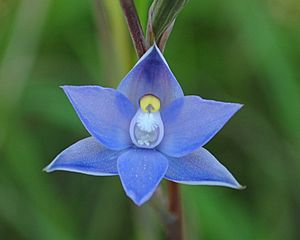Thelymitra nuda facts for kids
Quick facts for kids Plain sun orchid |
|
|---|---|
 |
|
| Thelymitra nuda near Sunbury | |
| Scientific classification | |
| Genus: |
Thelymitra
|
| Species: |
nuda
|
| Synonyms | |
The plain sun orchid (Thelymitra nuda) is a special type of orchid that only grows in eastern Australia. It has a single, thick leaf and can have up to twelve dark blue or purple flowers. Sometimes, these flowers can even be white or pink! A cool feature of this orchid is the white, fluffy tufts found on top of a part of the flower called the anther. You can find this orchid growing in many different places, and sometimes, lots of them grow together in big groups.
What is the Plain Sun Orchid Like?
The plain sun orchid is a tuberous plant, which means it grows from a swollen underground stem, like a potato. It is also a perennial herb, meaning it lives for more than two years and has soft, green stems instead of woody ones.
This orchid has one thick, channelled leaf that is blue-green to dark green. The leaf can be about 100–250 mm (4–10 in) long and 5–12 mm (0.2–0.5 in) wide, with a purplish base.
Up to twelve flowers grow on a stem that can be 150–500 mm (6–20 in) tall. Each flower is about 20–35 mm (0.8–1 in) wide. The flowers are usually dark blue or purple, but can also be white or pink. There are usually two small leaf-like parts called bracts along the flowering stem.
The sepals and petals of the flower are about 10–18 mm (0.4–0.7 in) long and 4–6 mm (0.16–0.24 in) wide. The central part of the flower, called the column, is pale bluish or pink. It is about 5–6.5 mm (0.2–0.3 in) long.
A special part of the flower is the lobe on top of the anther (where pollen is made). This lobe is dark brown to blackish and shaped like a tube, with a yellow tip and a small V-shaped notch. The side parts of the column have white, toothbrush-like tufts on their ends.
These orchids have a nice scent and their flowers can last a long time. They are pollinated by insects and only open on warm, sunny days. You can usually see them flowering in November and December.
How Did It Get Its Name?
The plain sun orchid was first officially described in 1810 by a botanist named Robert Brown. He published his description in a book called Prodromus Florae Novae Hollandiae et Insulae Van Diemen.
The second part of its scientific name, nuda, comes from a Latin word. It means "bare" or "naked."
Where Does the Plain Sun Orchid Grow?
The plain sun orchid likes to grow in different types of environments. You can find it in heathlands, woodlands, and forests. Sometimes, many of these orchids grow together, forming large groups.
This orchid is found in several parts of eastern Australia. It grows in New South Wales, south from a place called Mount Kaputar. It also grows in the Australian Capital Territory, Victoria, South Australia, and Tasmania.

